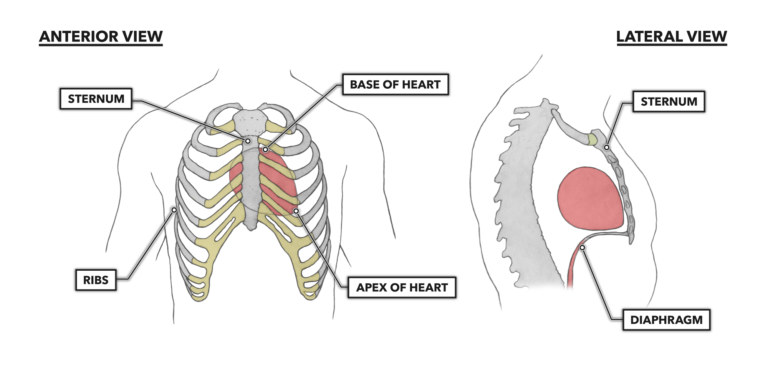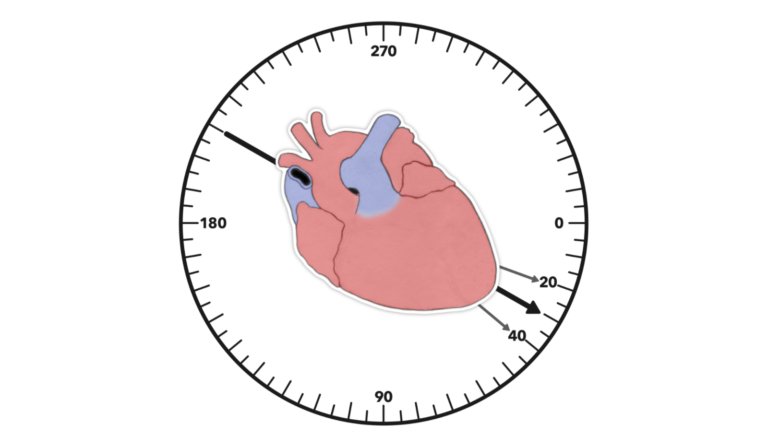The human heart is not a muscle we can touch. It lies at a slight downward angle from right to left, just posterior to the sternum. It is somewhat centered within the rib cage but biased to the left side. The big blood vessels coming out of its broad top are found toward the right, and the narrowed tip of the heart can be found toward the left. Its lowest excursion is above the level of the xiphoid process. It is nestled between the lungs, liver, and diaphragm and is endowed with some shock-absorbing and metabolically available adipose deposits (fat).

Figure 1: Location and orientation of the heart
The heart has a base and an apex, but those landmarks are not necessarily intuitive. “Apex” is often associated with the highest or culminating point of an object,” while “base” is used to refer to the bottom of an object or its support. The apex of the heart is its sharpest point; it is located at the bottom of the heart, angled down and forward. The base of the heart is its superior aspect, but the base still retains a support function as it connects the heart to suspensory tissues.
The longitudinal line from the center point of the base of the heart to the point of the apex is called the anatomical axis. Most studies, beginning as early as the 1940s, indicate a normal heart will lie within the thoracic cavity at an angle of about 20 to 40 degrees. Various physiological phenomena, such as obesity, can displace the heart, moving the anatomical axis outside this norm and affecting cardiac function.

Figure 2: Normal range for the anatomical axis of the heart. Note the anatomical axis represented here is different from the electrical axis as determined by electrocardiography.
The human heart is a muscular organ, not too large in size, tipping the scales at between half a pound and three-fourths of a pound (250 to 350 grams). A very quick and easy way to estimate and visualize the size of your heart is to simply make a fist. In general, the size of the heart is related to the size of the body containing it. A small body has a heart on the smaller end of the scale of norms, and a large body has a heart on the larger end of the scale. This is true for nonhuman animals as well. For instance, a rat heart is about the size of the last joint segment of your ring finger; an elephant heart is bigger than a basketball.
The heart is mostly comprised of muscle wrapped around enclosed spaces. The arrangement of these spaces, or chambers, of the heart is important, because they allow the heart to serve as a biological fluid pump, moving blood to all points in the body that have blood vessels.
The heart pumps blood 24/7, from birth to death. If we consider the average lifespan to be 76 years, with an average heart rate of 70 beats per minute, that works out to 2,796,192,000 pumping actions over the course of a lifetime. That is a large number of contractions. The energy required to drive blood through the vessels has been calculated to be 0.0023 calories per heartbeat. This means we use roughly 6,518,900 calories over our lifespan or about 235 calories each day to power the heart.
The Heart, Part 1: Location & Orientation